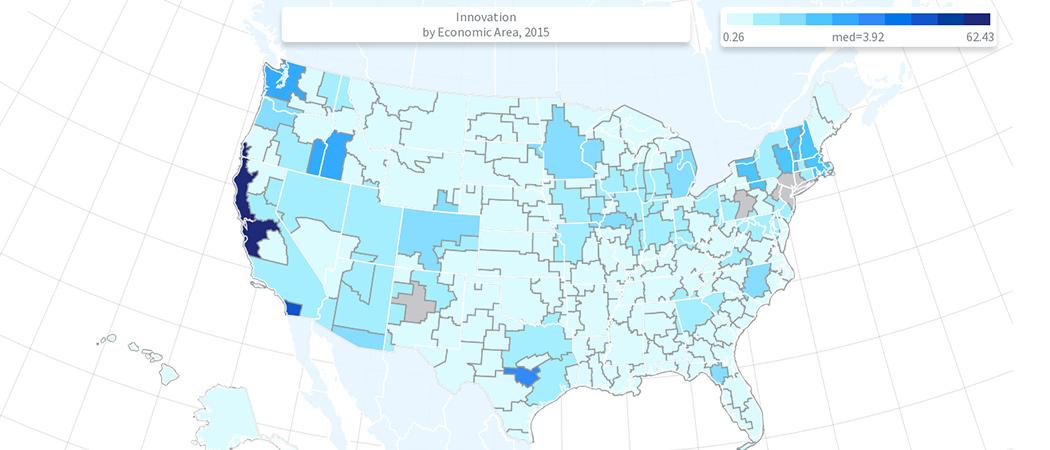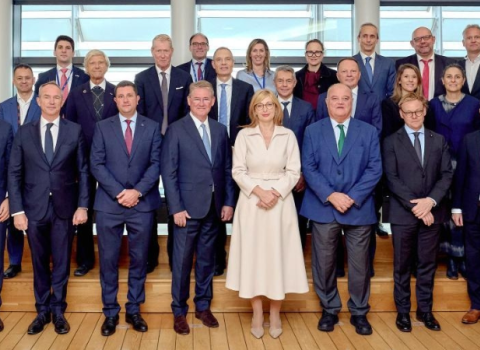NSF Engines, a new programme of the US National Science Foundation, aims to spread the tech wealth more broadly across the nation – tackling a regional policy problem common to many countries

The map of US innovation clusters in 2015 - dark blue for innovation leaders, light blue for laggards (grey for missing data.) Source: US Cluster Mapping Project, Harvard Business School.
Editor’s note: Starting today, Science|Business provides a regular news column on innovation in North America relevant to an international audience. The author is Lori Valigra, a US-based journalist with extensive experience covering science, technology and business internationally. Have a suggestion for Lori? Write her at [email protected]
The US National Science Foundation unveiled a new programme in early May aimed at expanding the nation’s innovation ecosystem beyond the large, successful clusters in Boston and the West Coast to secondary cities with undeveloped tech potential.
In doing so, the famed US science funder is trying a new approach to a problem faced by most developed countries: How to spread the tech wealth more broadly? How this American programme fares will no doubt be tracked by research policy-makers world-wide.
The so-called NSF Engines programme goes beyond the agency’s focus to date on scientific innovation to promote national prosperity, which it has done successfully since being created by Congress in 1950.
In a new twist, NSF Engines emphasises engaging consumers of research outcomes in helping shape the research questions; prototyping and piloting research-based solutions; and translating research results into practice, entrepreneurship, and workforce development. The aim is to prompt economic growth in secondary areas such as Pittsburgh or Indianapolis where innovation activities are loosely connected. It also aims to engage those underserved in STEM such as historically Black colleges and universities, Hispanic-serving institutions, and Tribal colleges and universities.
“It’s a concerted effort to bring a geographical, or place-based, lens to innovation,” said Mark Muro, senior fellow and policy director at Brookings Institution, a Washington, DC-based research group. “It looks like they’re thinking a lot about what ensures that our regional ecosystems function properly and calling for regions to figure out how they can align the key actors.”
He said the US has a lot of innovation, but only in a few places. Boston, San Francisco, San Jose, Seattle, and San Diego made up more than 90% of the US innovation growth from 2005 to 2017, according to the Brookings Institution. As a result, one-third of the US innovation jobs reside in only 16 of the more than 3,000 total US counties. Washington politicians would like to see more money spread around the country to stimulate innovation and jobs.
The NSF Engines programme will focus on geographical locations that can range from a metropolitan area and its adjacent rural regions to an area spanning several states. Each engine will develop and implement a strategic plan for producing a culture of innovation, with funding to establish the engine and its activities distributed among partners.
Contrasting with earlier NSF programmes, the level of post-award oversight will be more rigorous because of the high award amounts, with tracking of technology translation and workforce development.
NSF Engines, which is currently looking for proposals, will offer five Type 2 awards of up to $160 million each over as many as 10 years. They will support awardees in a geographical region ready to evolve a regional innovation ecosystem.
Type-1 awards, which offer a maximum of $1 million for up to 24 months, may be more significant to sparking new innovation ecosystems and can serve as a prototype for a Type-2 award. Fifty awards will be given out as seed funding to applicants to lay the groundwork to establish a new NSF Engine for a specific topic area. Concept outlines for both types of awards are due on 30 June 2022.
“That’s a substantial incentive and infusion for a place that may not have a strong history to develop a plan, to work out relationships and partnerships and to do the needed design research to really create something valid,” said Muro. “I think that’s a very important dimension of this.”
He worries that without such an incentive for newcomers, the money would fall back to fairly established places.
The NSF has been a world leader in using mission-driven grants to incentivise scientific research. Europe also has created several programmes with mission-driven grants, including Horizon Europe, which allows US researchers to join European research consortia – usually as unpaid participants, but under special circumstances with EU funding.
NSF Engines does not allow international partners in the proposal phase, but once an award is made, an international partner or collaborator may be added under specific NSF award procedures, said Keith Boyea, deputy director of NSF’s division of acquisition and cooperative support.
However, the new programme will allow partners in the US outside the geographical area of the awardee, said Erwin Gianchandani, assistant director of the NSF’s Technology, Innovation and Partnerships programme. That could complement other efforts underway that include investments from NSF or other agencies. It also would encourage mentoring from experienced organisations in existing mature innovation ecosystems. NSF Engines will include academic institutions, non-profits, for-profit companies, government entities, and others.
In an open letter to scientific colleagues, Gianchandani said that to ensure the U.S. stays competitive and leverages emerging technologies to tackle large-scale societal and economic challenges, “it is essential that the U.S. expand domestic innovation capacity. To do so requires taking full advantage of the diverse innovation potential and talent across the entire nation.”
Muro said the programme reflects that the nation is ready to try to do something about the unevenness of innovation centers across the country.
“This is a thoughtful, well-resourced initiative that seeks to stimulate innovative ecosystems in new places,” he said. “Increasingly actors in Washington are actually putting their money where their mouth is about this issue. It’s good to see.”





 A unique international forum for public research organisations and companies to connect their external engagement with strategic interests around their R&D system.
A unique international forum for public research organisations and companies to connect their external engagement with strategic interests around their R&D system.